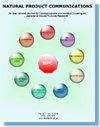通过代谢组学和药理学方法探索不同加工技术对桔梗镇咳祛痰剂的影响
IF 1.4
4区 医学
Q4 CHEMISTRY, MEDICINAL
引用次数: 0
摘要
背景与目的桔梗是一种传统中药材,具有宣肺利咽、祛痰排脓的功效。其加工历史最早见于中国晋代的《周后备急方》。通过加工,可以丰富植物中的有效物质,减少负面物质。实验方法采用Nexera UHPLC LC-30A-HILIC-Orbitrap-Q Exactive HF-X平台分析桔梗加工前后代谢物的变化。结果加工后桔梗的部分代谢物发生了变化,其中24种萜类代谢物变化明显。通过氨气致小鼠咳嗽实验和酚红祛痰实验发现,鲜桔梗40%、鲜桔梗80%、干桔梗40%和干桔梗80%均有明显的镇咳作用,干桔梗40%有明显的祛痰作用。结论与启示有些加工方法确实能进一步提高桔梗的镇咳和祛痰作用,这可能是由于加工后增加了三萜类化合物的含量,但加工提高镇咳和祛痰作用的机理还需要进一步研究。本文章由计算机程序翻译,如有差异,请以英文原文为准。
Exploring the Effects of Different Processing Techniques on the Antitussive Expectorant of Platycodon grandiflorus by Metabonomics and Pharmacologic Methods
Background and PurposePlatycodon grandiflorum is a traditional Chinese herbal medicine, which can disperse lung, promote pharynx, dispel phlegm and expel pus. Its processing history was first seen in the “Zhou Hou Bei Ji Fang” of the Jin Dynasty in China. Through processing, effective substances in plants can be enriched and negative substances can be reduced. Therefore, this study explored the effects of different processing methods on the antitussive and expectorant effects of Platycodon grandiflorum through metabolomics and pharmacology, aiming to provide a theoretical basis for clinical application.Experimental ApproachThe changes of metabolites before and after processing of Platycodon grandiflorum were analyzed by Nexera UHPLC LC-30A-HILIC-Orbitrap-Q Exactive HF-X platform. The antitussive and expectorant effects of processed Platycodon grandiflorum were verified by mouse concentrated ammonia induced cough method and tracheal phenol red drainage method.Key ResultsAfter processing, some metabolites of Platycodon grandiflorum changed, among which 24 kinds of terpenoid metabolites changed significantly. Through the experiment of ammonia-induced cough in mice and phenol red expectorant experiment, it was found that fresh JZI 40%, fresh CZ 80%, dry JZZ 40% and dry JZI 80% had obvious antitussive effect, and dry JZZ 40% had obvious expectorant effect.Conclusions and ImplicationsSome processing methods can indeed further improve the antitussive and expectorant effects of Platycodon grandiflorum, which may be due to the effect of increasing the content of triterpenoids after processing, but the mechanism of processing to improve the effect of relieving cough and expectorant needs further study.
求助全文
通过发布文献求助,成功后即可免费获取论文全文。
去求助
来源期刊

Natural Product Communications
工程技术-食品科技
CiteScore
3.10
自引率
11.10%
发文量
254
审稿时长
2.7 months
期刊介绍:
Natural Product Communications is a peer reviewed, open access journal studying all aspects of natural products, including isolation, characterization, spectroscopic properties, biological activities, synthesis, structure-activity, biotransformation, biosynthesis, tissue culture and fermentation. It covers the full breadth of chemistry, biochemistry, biotechnology, pharmacology, and chemical ecology of natural products.
Natural Product Communications is a peer reviewed, open access journal studying all aspects of natural products, including isolation, characterization, spectroscopic properties, biological activities, synthesis, structure-activity, biotransformation, biosynthesis, tissue culture and fermentation. It covers the full breadth of chemistry, biochemistry, biotechnology, pharmacology, and chemical ecology of natural products.
Natural Product Communications is a peer reviewed, open access journal studying all aspects of natural products, including isolation, characterization, spectroscopic properties, biological activities, synthesis, structure-activity, biotransformation, biosynthesis, tissue culture and fermentation. It covers the full breadth of chemistry, biochemistry, biotechnology, pharmacology, and chemical ecology of natural products.
 求助内容:
求助内容: 应助结果提醒方式:
应助结果提醒方式:


